
























Ohio Cooperative Living magazine is seeking photography submissions from our electric cooperative members. Send us beautiful landscape, wildlife, and floral photos from your cooperative hometown. Winning submissions will cash prize and be published in the 2025 edition of the cooperative calenda
• One photo entry per household.
• High-resolution, color, digital images only.
• Only JPEG or TIF file formats will be accepted.


• Please send submissions by email attachment only to photo@ohioec.org.
• Photo format must be horizontal and capable of filling an 8x11-inch image area.
• Provide an explanation of the photo — the where, what, when — as well as who took the photo.
• Include your name, address, phone number, and the name of your co-op. For more information, visit OhioCoopLiving.com/calendar
DEADLINE FOR SUBMISSION: AUGUST 16, 2024



22 DADDY LONGLEGS
The gangly harvestmen are about to emerge from hiding to get ready for the long winter.
25 OHIO SCUBA
The Buckeye State offers a variety of open-water diving experiences.
28 BIG MEMORIES
Big Muskie’s giant bucket is all that remains from a bygone era of strip mining in eastern Ohio.
30 ROADSIDE SHRINES
Impromptu memorials that often pop up after a tragedy help the grieving and serve as reminders to drive with care.
Cover image on most editions: Ohio might not be the first place you think of for scuba diving, but the prevalence of abandoned quarries, many of which are fed by clear spring water, has spawned a small but growing number of underwater enthusiasts (photograph courtesy of Rich Synowiec/White Star Quarry).
This page: The gangly daddy longlegs, despite its eight appendages, isn’t a spider — whereas spiders have segmented bodies, daddy longlegs have a single body segment. They also have no fangs or venom glands, and they don’t spin webs (photograph by Henrik_L via Getty Images).

Every year for decades, the planet has used more energy than the year before, spurred largely by the improving standard of living in developing areas. At the same time, the world has tried to move away from fossil fuel dependence and toward renewable sources in the worthwhile hopes of reducing environmental impact and gaining more independence from supply sources that are unreliable or unfriendly (or both). New energy supply technologies, therefore, always attract plenty of attention.
Still today, as has been the case for the past century, we are powered by fossil fuels. In fact, despite tremendous investment and favorable tax treatment for renewable and other new energy sources, the world has relied on steady increases in fossil fuel production to meet a nearly constant 80% of our energy needs.
There is no doubt that new and emerging technologies continue to transform our daily lives — usually for the better. Significant developments over the past several decades have reduced the impact of burning fossil fuels: improved means of converting wind and solar energy into electricity; increased efficiency of combustion engines and turbines; new and better batteries that can store larger quantities of electric energy; enhanced oil and natural gas drilling and recovery methods; and better environmental control equipment that keeps byproducts out of our air, soil, and water.
But none of these innovations and improvements has yet been a “game changer.” It’s a simple fact that, because of the sheer scale of the energy infrastructure needed to power our lives, it takes years (and more likely decades) for even the most innovative discovery to have a meaningful effect.
We don’t know exactly what our ingenuity will come up with next, but we can be certain that whatever it is, it will take time to be developed and deployed. Meanwhile, power producers still have a responsibility to keep up with the world’s constantly growing demand, so we can’t just sit back and wait. We need to keep utilizing our proven, reliable, and economical “traditional” energy infrastructure at the same time we work to develop the “next big thing.”
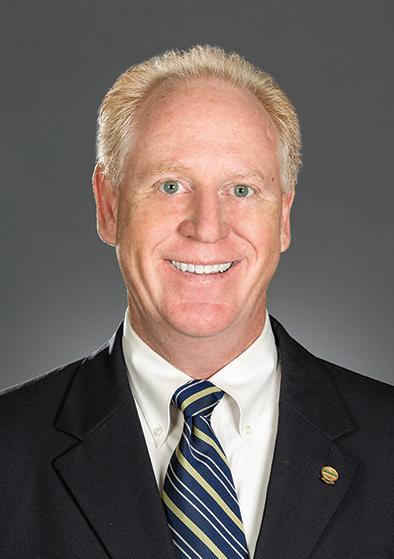
Pat O’Loughlin PRESIDENT & CEO OHIO’S ELECTRIC COOPERATIVES
Because of the sheer scale of our energy infrastructure, it takes years (and more likely decades) for even the most innovative discovery to have a meaningful impact.
6677 Busch Blvd. Columbus, OH 43229 614-846-5757 www.ohiocoopliving.com
Patrick O’Loughlin President & CEO
Caryn Whitney Director of Communications
Jeff McCallister Senior Managing Editor
Amy Howat Assistant Managing Editor
Neal Kindig Graphic Designer
Contributors: Jodi Borger, Margaret Buranen, Colleen Romick Clark, Getty Images, W.H. “Chip” Gross, Catherine Murray, James Proffitt, Craig Springer, and MJ Zindars.
OHIO COOPERATIVE LIVING (USPS 134-760; ISSN 2572-049X) is published monthly by Ohio Rural Electric Cooperatives, Inc. It is the official communication link between the electric cooperatives in Ohio and West Virginia and their members. Subscription cost for members ranges from $5.52 to $6.96 per year, paid from equity accruing to the member.
POSTMASTER: Send address changes to editorial and advertising offices at: 6677 Busch Boulevard, Columbus, OH 43229-1101. Periodicals postage paid at Berne, IN 46711, and at additional mailing offices. Nothing in this publication may be reproduced in any manner without written permission from Ohio Rural Electric Cooperatives, Inc. All rights reserved. The fact that a product is advertised in Ohio Cooperative Living should not be taken as an endorsement. If you find an advertisement misleading or a product unsatisfactory, please notify us or the Ohio Attorney General’s Office, Consumer Protection Section, 30 E. Broad St., Columbus, OH 43215. Periodicals postage paid at Columbus, OH, and at additional mailing offices.

Between a rock and a hard place: The EPA says fossil fuel power plants must shut down if they can’t capture and store the carbon they produce. 8
An old salt: Underneath Ohio’s largest lake, a pair of mines produce an unexpected treasure. 10
Hops to it: Cash crop allows patient Ohio farmers to take advantage of the craft brewery boom. 13
Vim and vinegar: There’s some in every pantry; put it to flavorful use in these yummy recipes.
News and other important information from your electric cooperative.



National/regional advertising inquiries, contact Cheryl Solomon
American MainStreet Publications 847-749-4875 | cheryl@amp.coop
Cooperative members:
Please report changes of address to your electric cooperative. Ohio Cooperative Living staff cannot process address changes.
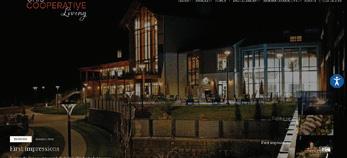
What’s happening: August/ September events and other things to do around Ohio.
Diving board: Members go off the deep end to share memories of summertime fun!

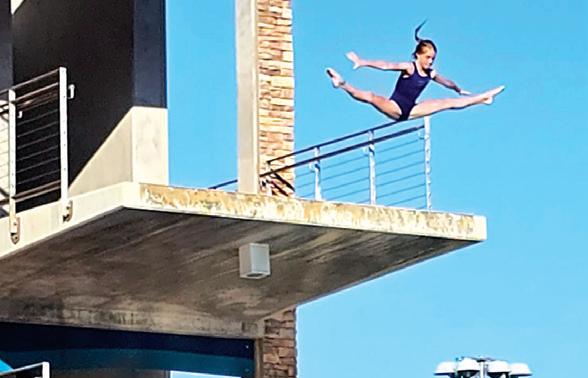

Because the only other option is a gamble on technology that may not work here, new EPA rules would force the closure of Ohio co-ops’ main source of reliable power.
BY JEFF MCCALLISTER
The U.S. Environmental Protection Agency’s new Greenhouse Gas Standards and Guidelines for Fossil Fuel-Fired Power Plants requires aggressive action to drastically reduce emissions of carbon dioxide from conventional electricity-generating facilities such as the Cardinal Power Plant, the co-op member-owned generation facility on the Ohio River in Brilliant.
The rule offers basically two ways for plants like Cardinal to reduce their CO2 emissions by 90%: Either invest billions of dollars in a system known as carbon capture and sequestration (CSS), or shut down altogether.



The white plume rising from the stacks at the coal-fired Cardinal Power Plant in Brilliant is nearly all water vapor. Buckeye Power, the member-owned generation and transmission cooperative that operates the plant, has invested more than $1 billion to install equipment that has made it one of the cleanest generating stations of its kind in the world.


Buckeye Power, the generation and transmission cooperative that operates Cardinal on behalf of the state’s 25 not-for-profit electric distribution cooperatives, relies on the plant for more than 80% of the power it delivers to more than 400,000 homes and businesses every day. From the start, Buckeye has maintained a commitment to environmental responsibility as part of
“Buckeye Power has invested more than $1 billion in environmental controls over the past 20 years,” says Pat O’Loughlin, Buckeye’s president and CEO. “To put it in perspective, that’s over half of everything we’ve invested in the entire history of our company, and those investments have produced dramatic results in cleaner air, cleaner water, and significantly reduced solid waste such as ash.”
The improvements, in fact, not only met but usually exceeded EPA standards, and made Cardinal one of the cleanest coal-burning power plants in the world. Of course, they also increased the cost of producing electricity — a trade-off generally accepted by co-op members.
The new rules have been challenged in federal court by a consortium of utilities, trade groups, and attorneys general from 27 states, including Ohio. Troy Balderson, a Republican U.S. Representative from Zanesville, introduced legislation to overturn the standards, and Democratic Sen. Sherrod Brown announced that he will support a similar effort in that chamber, specifically citing harm to energy industry workers and rural electric cooperatives.
That’s why the new EPA rule puts Buckeye Power in such a tough spot; if Cardinal must shut down, Buckeye still would have to both pay off those previous investments and provide the power needed for members to keep their lights on 24 hours a day — but would have to do so without its most economical and reliable assets.
It likely would mean purchasing power on the open market, which is not a cheap proposition, especially in the harsh weather conditions that set Cardinal’s reliability in stark contrast to renewables like wind and solar.
Because co-ops are member owned and not for profit, all of those increased costs would have to be borne by members through significantly higher electric bills.
To avoid shutting the units down, the EPA offers the option to use CCS to meet that 90% reduction — a standard that
Continued on page 6
must be met by 2032, less than eight years from now. The EPA, in announcing its rule, even pointed to one of Buckeye’s sister generation co-ops, Minnkota Power of North Dakota, and its “Project Tundra” CCS initiative, as proof that it can be done.
Minnkota has been working on Project Tundra for almost 10 years at its 700-megawatt Milton R. Young Power Plant near Bismarck, North Dakota, making significant progress on engineering and design, permitting, and regulatory compliance.
The problem is, it’s still just a concept; even after nearly a decade, no construction has yet taken place. Now Minnkota’s CEO has announced a delay in the project because of uncertainty about the EPA’s guidelines.
So, despite the EPA’s assertion, no project has ever even been designed that would meet the requirement — at least not at the scale that would be required at Cardinal.
“There have been a few instances where smaller amounts of flue gas have been cleaned to near 90%, most of the time,” O’Loughlin says. “Our Cardinal Plant is 1,800 megawatts. That’s a big jump. It would be a huge gamble to commit billions of dollars of our members’ money to something that we’re not sure will do what the EPA is requiring, and certainly will not do it in the time frame they’re demanding.”
CCS at Cardinal would require the design and construction of, in essence, a major chemical plant on-site to capture the carbon from the plant’s emissions. Such a chemical plant would have its own electrical needs that would use roughly 25% of the energy that Cardinal produces, according to O’Loughlin. Once the carbon is separated, it would then require a pipeline to a geologically sound deep-well location to store it. (Ohio’s geology, much less favorable to that process than North Dakota’s, presents its own challenges.)
“Right now, the technology remains in a nascent and experimental state that is not technically or commercially viable for Cardinal,” says Craig Grooms, Buckeye Power’s chief operating officer, in a declaration of harm filed with the D.C. Circuit of the U.S. Court of Appeals. And even if it were, he continues, “permitting, siting, design, and construction standards for CCS — including for CO2 storage and CO2 pipeline transportation from Cardinal to storage, as well as the CO2 capture technology itself — mean that any such CCS system could not be placed into service by the January 1, 2032, compliance date required by the final rule.”
In other words, says O’Loughlin, “Cardinal, and likely every other coal plant in the country, will not be able to comply with the rule, and will be left no choice but to shut down. Our grid will become much less reliable, and electricity will become a lot more expensive.”
Voices for Cooperative Power is a grassroots network of electric co-op members who help shape public policy by sharing concerns with policymakers. Find helpful links to connect you with government leaders at https://voicesforcooperativepower.com/act-now-epa.

Electric cooperatives are at the forefront of the drive toward clean carbon solutions. Above, Minnkota Power Cooperative’s Milton Young Plant began working to add carbon capture technology in 2015. Officials hope to begin construction later this year. Below, Basin Power’s Dry Fork Plant is home to the Wyoming Integrated Test Center, where researchers use 5% of the 400-megawatt plant’s flue gas to search for potentially workable new technology in a real-world setting.

Under the right conditions, carbon capture and storage (CCS) could be a viable method for reducing carbon dioxide emissions while preserving the reliability and dependability of fossil-fuel power plants. There are a handful of utilities testing this ambitious technology in the U.S., particularly in areas where favorable underground geology is thought to be ideal for storing CO2. Here’s how CCS works.
Amine solution is used to separate CO2 from fossil fuel power plant flue gases.
Compressed CO2 is transported via a pipeline to an injection wellhead.
CO2 is injected into porous rock formations deep underground.



“Now Jack can control the volume on his TV•Ears while I set the TV volume or mute it for complete quiet. Once again, he can understand every word and we can watch our favorite TV shows together.” — Darlene & Jack B., CA

Doctor recommended TV•Ears has helped millions of people with hearing loss enjoy their favorite television shows, movies and streaming content without disturbing others.
The Voice Clarifying Technology® reduces background noise and clarifies hard to hear television dialog making voices and words understandable. 120db of volume makes TV•Ears the most powerful television listening system on the market!
Quiet TV mode lets others mute the television or set the volume to their preferred level while you listen as loud as you want on the headset.

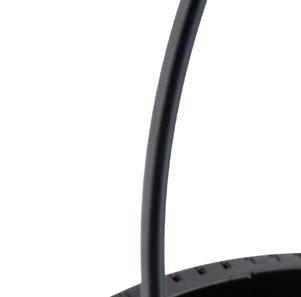























Underneath Ohio’s largest lake, a pair of mines produce an unexpected treasure.
BY W.H. “CHIP” GROSS
Amultitude of boaters, anglers, swimmers, vacationers, sun-chasers, and thrill-seekers flocks to Lake Erie each summer. Most of them will have no idea of the activity taking place far beneath those waters.
For the past 65 years, nearly half a mile down, two massive salt mines have been extracting more than 3 million tons of rock salt per year for use to melt snow and ice on Ohio’s winter streets, roads, and highways.
The entrance to one of the mines, operated by Cargill, Inc., is just offshore from downtown Cleveland on Whiskey Island (so named when a distillery was built on the site in the 1830s). The second mine, operated by Morton Salt, is 30 miles farther east along the lakeshore at Fairport Harbor. The property and mineral rights under the lake are owned by the State of Ohio, but the mineral rights are leased to the two operators.
“Geologists believe that the salt beds formed eons ago when an ancient, relatively shallow saltwater sea covered what one day would become the Buckeye State,” says Chris Wright, Ohio Department of Natural Resources, Division of Geological Survey program supervisor. “As the waters continually ebbed and flowed in the warm tropical climate, evaporation occurred, leaving salt beds that today in some parts of Ohio measure 40 to 50 feet thick.”
The construction of the two mines took place during the late 1950s; the initial vertical shaft of each mine, sunk to a depth of about 2,000 feet and measuring about 16 feet in diameter, took about two years to complete. At that depth, the shafts take a 90-degree turn, heading north under the lake bed.
Today, the horizontal mine passageways extend several miles under the lake. The large, powerful equipment
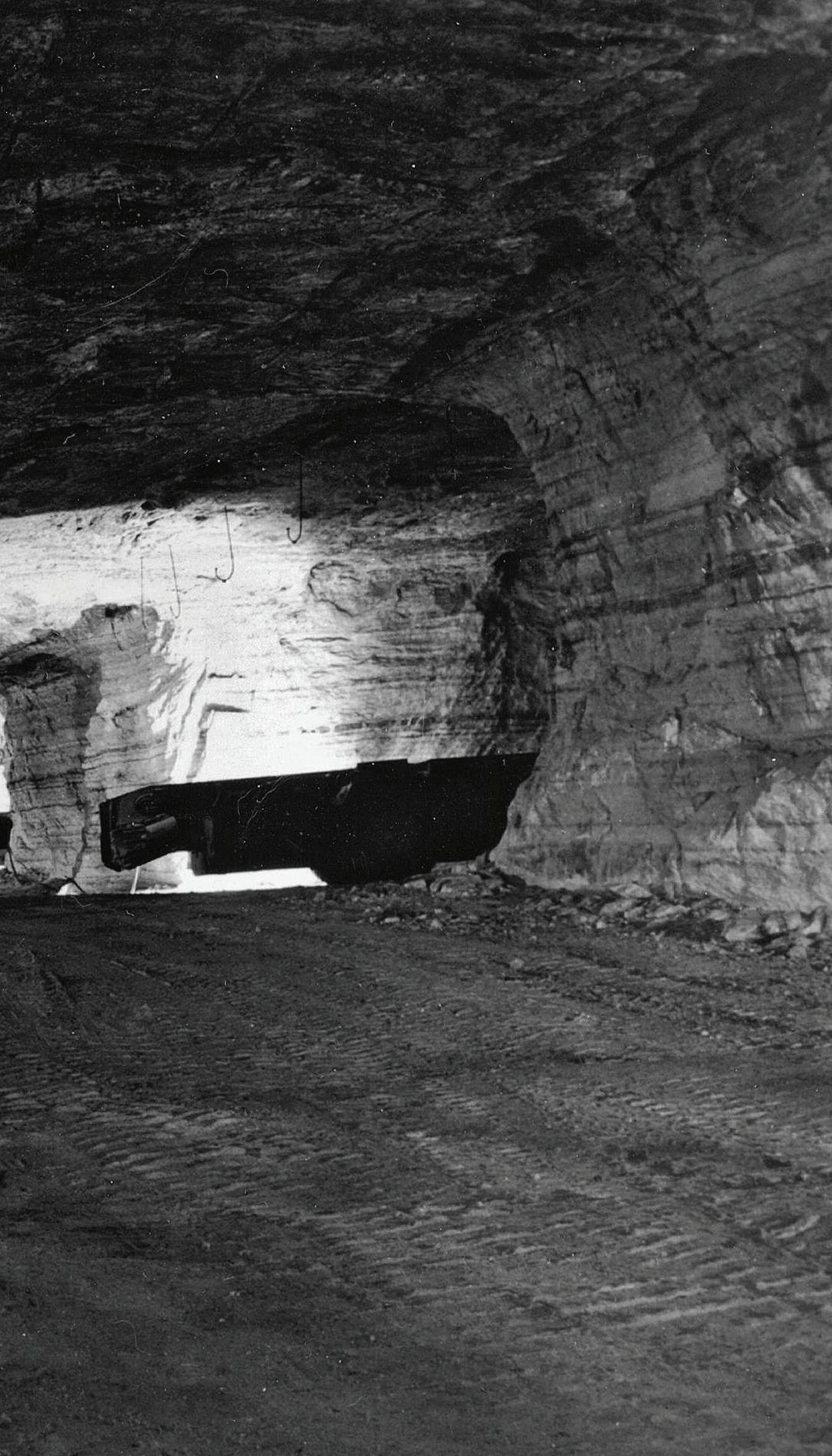


needed to mine the salt — trucks, front-end loaders, conveyors, etc. — was lowered into the mines by first disassembling the machines into their component parts, then reassembling them at the bottom of the shaft.
The salt beds cover a vast area that includes most of eastern Ohio, western Pennsylvania, western New York, southwestern Ontario, central Michigan, and into northern West Virginia. So, why are the two Ohio mines located on the Erie shore?
“The answer is twofold,” Wright says. “Even though various salt layers can be found over a huge area, in Ohio they are closest to the surface along the lakeshore, making it more

cost-effective to mine there. And secondly, it was much simpler for the operators to acquire the mineral rights from one entity — the State of Ohio — than deal with the many, many individual landowners who would have needed to be contracted inland.”
The mining itself is accomplished using what’s known as the room-and-pillar technique, in which about half of the salt in a particular “room” is removed, leaving a passageway, and the other half is allowed to remain in place as support pillars for the ceiling. To loosen the rock salt at the working face of the mine, small-diameter holes are drilled about 10 feet deep into the salt, spaced every few feet. Explosive charges are placed into the holes and detonated, and the loosened salt can then be scooped up, placed in trucks, and moved to the conveyors that take it to the main shaft and eventually to the surface.
Shallow mines are a lot like caves, which usually remain at the median temperature of the environment surrounding them. For example, Ohio Caverns near West Liberty is 103 feet deep and is a constant 54 degrees year-round, which is the median temperature for that part of Ohio.
“The natural temperature within the deeper salt mines is also relatively constant,” Wright says. “About 70 degrees, with the temperature actually warming a few degrees as you descend deeper and deeper underground, due to geothermal heat.”
An interesting side note is that the salt beds in the mines are constantly “flowing,” according to Wright — albeit at a literal glacial pace. Because of the extreme pressure of the rocks above the salt beds, the rock salt attempts to fill the empty spaces where salt has already been mined. As a result, some sections of the mines are no longer safe to enter because they have become unstable.
“There is no danger of cracks reaching all the way up to the bottom of Lake Erie and allowing the lake water to suddenly flood the mines,” Wright says. “It’s really nothing to worry about.”
W.H. “Chip” Gross is Ohio Cooperative Living’s outdoors editor. Email him with your outdoors questions at whchipgross@gmail.com. Be sure to include “Ask Chip” in the subject of the email. Your question may be answered on www.ohiocoopliving.com!

BY MARGARET BURANEN
According to the Ohio Craft Brewers Association, there were 434 craft breweries in the state of Ohio at the end of 2023. More are opening all the time.
And that gigantic growth curve has created an equally growing opportunity for a number of Ohio farmers: Those breweries need hops.
Hops add bitterness to balance the sweetness of malt in beers. Different varieties of hops contain varying levels of oils and acids, and those are what give beers their distinct flavors.
“Different breweries want different varieties of hops,” says Amy Berridge, a member of Kenton-based Mid-Ohio Energy Cooperative. Berridge, her mother, Rubiana Berridge, and her sister, Lori Tucker, own Three Chicks Farm in Morral, in Marion County. In 2014, Three Chicks added hops to its lineup of crops, which also includes soybeans, wheat, alfalfa hay, and Christmas trees.

“When we were considering growing hops, they told us that it would be easy and make a lot of money,” Amy Berridge says. “It is neither.”
Logan Minter, associate professor and extension and field specialist for specialty crops at Ohio State University’s South Center, says hops grew wild in Ohio until Prohibition, but then hop production shifted to northwestern states. Part of Minter’s research now involves finding and cultivating wild hop plants. He hopes to find strains that are more resistant to insects or have other beneficial properties.
Minter confirms that, while hop acreage in Ohio has increased in the last 10 years, the number of those growing the stuff has declined despite the demand.
“First, it’s a labor-intensive crop,” he says. “Then there is a relatively high installation cost, and a significant annual operations cost after that.”
Minter says with all that initial investment, it takes about three years for a farmer to break even, and only then will


most farmers begin to make a profit from their work; Berridge says that was her experience as well.
The hop yard at Three Chicks Farm measures threequarters of an acre. They began with small, established plants their first year, and those plants took about three years to develop enough roots to produce a full crop. They’ve since added a second variety. Once established, Minter says, hop plants will produce a crop for 25 years or more, though they are susceptible to various diseases and pests and require a certain vigilance.
The plant itself is referred to as a hop; its flowers are the hops that flavor your brewski. Hops flowers are referred to as cones, because they look like small green pine cones. The cones grow on bines (bines, not vines) that are supported on strings. Some growers use strings made of coir from coconuts, but Three Chicks uses special hop strings made of paper. Metal cables hold the strings to wooden poles or trellises that stand 16 to 20 feet tall.
For the September harvest, “we cut off the bines close to the ground and untie them from the trellises,” Berridge
Continued on page 12






says. “Then the bines and strings go through a mechanical harvester that separates the cones and sends them out the side.”
Berridge says that most breweries want the cones in pellet form for efficiency and consistency. So after the cones are removed from the bines, they are sent away to be dried, converted into pellets, and then put in bags to be sold.
While breweries are the major customers for hops, there are other uses. The citrus-like scent of the cones makes them suitable for some cosmetics. Tea made from hops (Berridge’s verdict: “not bad”) can promote sleep. Hops can be used to flavor food as well.
“We made some macaroons with hops,” Berridge says. “They were really good and won first place at the Marion County Fair.”
As labor-intensive as it is to grow hops, Berridge says, selling them is even harder. “You have to sell directly to your customers, to build relationships with them, because there is no central marketplace for hops,” she says.
To that end, Berridge is also a member, and treasurer, of the Ohio Hop Growers Guild, which has about 70 members who can lean on one another for help with everything from pest control to sales and marketing. The guild connection led Three Chicks to an arrangement with another hop farm to sell its hops.
And even with cooperation among the guild, Minter sums up hop growing and beer production: “It’s a lot easier to drink beer than it is to make it.”







































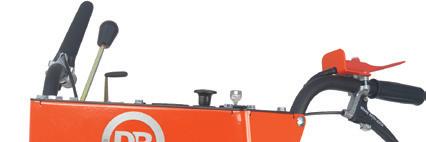








• Up to 2X the power of the competition

• Cut overgrown brush, tall field grass, and saplings up to 3" thick



• Commercial, Electric, Walk- and Tow-Behind models available, including the NEW PRO MAX60T!




























There’s some of the sour stuff in every pantry; put it to flavorful use in these yummy recipes.

Prep: 10 minutes | Chill: 4+ hours | Cook: 7 minutes | Servings: 4
1 pound boneless skinless chicken breast
1¼ cups dill pickle juice (jarred vinegar pickles, not fermented)
1 tablespoon brown sugar
½ teaspoon salt
1 teaspoon black pepper
NOTE: Pickle juice is chock-full of vinegar, which makes for a flavorful, tender, and juicy chicken marinade. Other uses for pickle juice: Pickle another batch of vegetables, liven up potatoes, add a dash to a Bloody Mary, or pour over unwanted garden weeds! Slice chicken breasts in half for thinner pieces, which are better for marinating and grilling. In a container with lid, mix together all ingredients except chicken, then submerge chicken in marinade, cover, and refrigerate for 4 to 8 hours.
Preheat grill to 350 F. Lightly oil grates to prevent chicken from sticking. Using heat-safe tongs, pull chicken out of marinade, shake off excess, and place on grill. (Discard marinade.) Cook 5 to 7 minutes per side, until internal temperature reaches 165 F. Remove from grill and let rest 5 minutes before serving. Pair with your favorite side dishes.
Per serving: 148 calories, 3 grams fat (0.5 gram saturated fat), 83 milligrams cholesterol, 167 milligrams sodium, 3 grams total carbohydrates, 0 grams fiber, 26 grams protein.
Prep: 15 minutes | Cook: 50 minutes | Servings: 6
5½ cups water
1 teaspoon salt
1 cup cornmeal
2 tablespoons salted butter
2 pounds Brussels sprouts, trimmed and cut in half
1 medium red onion, sliced in half moons
2 tablespoons olive oil salt and pepper
3 to 5 tablespoons balsamic vinegar, divided ½ cup crumbled feta cheese ½ cup chopped walnuts
NOTES: For crispy Brussels sprouts, follow the recipe as written. For more tender Brussels sprouts, use one baking pan and the vegetables will steam while roasting. For a meaty version, mix in some crumbled bacon or pair with chicken, beef, or pork tenderloin.
In a medium pot, bring water and salt to a boil. Sprinkle in cornmeal while continually whisking until polenta thickens enough to bubble and pop. Lower heat and switch to stirring with a spoon or silicone spatula to prevent burning for a few more minutes, then cook uncovered, stirring every 5 minutes until polenta thickens and separates from sides of pot, 40 to 50 minutes. If it becomes too thick or clumps, incorporate a bit more water. Stir in butter until glossy and smooth. While polenta is cooking, work on the Brussels sprouts.
Preheat oven to 400 F. On two shallow baking pans, toss Brussels sprouts and red onion with oil, spread out in a single layer, and sprinkle with salt and pepper. Roast 12 to 18 minutes. When they’re close to desired doneness, toss, drizzle with 2 to 3 tablespoons balsamic vinegar, and top with feta and walnuts. Roast another 5 minutes.
Portion out polenta in bowls, top with roasted Brussels sprouts, and drizzle with some more balsamic vinegar.
Per serving: 354 calories, 19 grams fat (6 grams saturated fat), 22 milligrams cholesterol, 342 milligrams sodium, 39 grams total carbohydrates, 7 grams fiber, 10 grams protein.
Prep: 10 minutes | Servings: 6
8 cups coarsely sliced green cabbage
½ cup shredded carrot
½ cup mayonnaise
1/3 cup+ red wine vinegar
¼ teaspoon salt
¼ teaspoon black pepper
In a large bowl, mix all ingredients — carefully at first, then as the cabbage wilts from releasing water, it’ll be easier to stir and incorporate the dressing. Refrigerate up to 4 days (give it a good stir before serving).
Per serving: 158 calories, 14 grams fat (2 grams saturated fat), 0 milligrams cholesterol, 212 milligrams sodium, 7 grams total carbohydrates, 3 grams fiber, 1.5 grams protein.


Prep: 20 minutes | Bake: 50 to 60 minutes | Servings: 9
Filling/streusel crumble
¾ cup packed brown sugar
1 cup flour
Cake batter
2 cups flour
2 teaspoons baking soda
½ teaspoon salt
1 stick unsalted butter, softened
½ cup packed brown sugar
2 tablespoons cinnamon
1 stick unsalted butter, softened
½ cup white sugar
1 teaspoon vanilla
1 cup apple cider
2 tablespoons apple cider vinegar
NOTE: Did you know the combination of 1 teaspoon baking soda and 1 tablespoon vinegar can be used in place of an egg (as a leveling agent) in many baked goods?
Make the filling/streusel: Cut butter into the dry ingredients (brown sugar through cinnamon) with a fork, pastry cutter, or food processor until a crumb forms and set aside.
Preheat oven to 350 F. In a medium bowl, mix cake batter’s flour, baking soda, and salt. In a large bowl with an electric mixer, cream butter, brown sugar, white sugar, and vanilla until lightened in color. Add half the dry ingredients to the bowl. When mostly combined, add apple cider and apple cider vinegar. Once combined, mix in remaining dry mixture. Finish off with a spatula to avoid overmixing.
Spoon/pour half the cake batter into a greased 8x8-inch (or 9-inch round) baking dish, covering all corners with batter. Sprinkle a thin layer of streusel crumbs over the batter, then pour remaining batter on top, smoothing out to the edges of the dish. Sprinkle remaining streusel in an even layer across the top. Place on a cookie sheet on the middle rack of the oven and bake 55 to 65 minutes — if streusel crumble darkens too quickly, lightly cover with aluminum foil. Cake is done when toothpick inserted in center comes out clean. Cool completely before cutting and serving.
Per serving: 408 calories, 11 grams fat (6 grams saturated fat), 27 milligrams cholesterol, 318 milligrams sodium, 74 grams total carbohydrates, 2 grams fiber, 4 grams protein.


“To you, it’s the perfect lift chair. To me, it’s the best sleep chair I’ve ever had.”
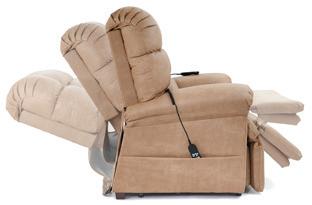

You can’t always lie down in bed and sleep. Heartburn, cardiac problems, hip or back aches – and dozens of other ailments and worries. Those are the nights you’d give anything for a comfortable chair to sleep in: one that reclines to exactly the right degree, raises your feet and legs just where you want them, supports your head and shoulders properly, and operates at the touch of a button.
Our Perfect Sleep Chair® does all that and more. More than a chair or recliner, it’s designed to provide total comfort. Choose your preferred heat and massage settings, for hours of soothing relaxation. Reading or watching TV? Our chair’s recline technology allows you to pause the chair in an infinite number of settings. And best of all, it features a powerful lift mechanism that tilts the entire chair forward, making it easy to stand. You’ll love the other benefits, too. It helps with correct spinal alignment and promotes back pressure relief, to prevent back and muscle pain. The overstuffed, oversized biscuit style back and unique seat design will cradle you in comfort.


— J. Fitzgerald, VA
Generously filled, wide armrests provide enhanced arm support when sitting or reclining. It even has a battery backup in case of a power outage.
White glove delivery included in shipping charge. Professionals will deliver the chair to the exact spot in your home where you want it, unpack it, inspect it, test it, position it, and even carry the packaging away! You get your choice of Luxurious and Lasting Miralux, Genuine Leather, stain and liquid repellent Duralux with the classic leather look, or plush MicroLux microfiber, all handcrafted in a variety of colors to fit any decor. Call now!












RANDY SPRANG BOARD CHAIRMAN
We understand that with busy schedules, many of you couldn’t attend the 2024 Annual Meeting. You were missed, but we utilize this publication every year to share the same information we share at the annual meeting. Your board is committed to providing transparency and communication for you, the member-owners of Holmes-Wayne Electric Cooperative.
It is a true pleasure to serve as the chairman of your board of trustees. Your board is dedicated and continually strives to achieve the goals of HWEC, namely:
• To provide electricity at the lowest cost possible
• To retain excellent customer service
• To always serve you according to our core principles and values
These principles are a key reason that America’s electric cooperatives operate differently from other electric utilities, putting the needs of their members first. This year’s election results demonstrate member confidence in the current board of trustees, as all three incumbents were reelected to three-year terms.
As your elected representatives, we serve as fiduciaries for the co-op and are required to make informed decisions that are in the best interest of the cooperative and our fellow members. We understand that our decisions can affect the rates you pay and the quality of service you receive, which is why we weigh our decisions heavily.
We are proud of our past successes and of all the employees who worked hard to attain them. Those successes add strength to the foundation from which future achievements will rise. But no matter how many “successes” we accrue, one thing remains paramount: Our members are the most important part of HWEC. Your cooperative is stronger because of your support and participation. We thank you for that.
Your cooperative continues to be a financially healthy organization. Financial stability is a crucial aspect for any organization, and cooperatives are no exception. We will work to maintain costs and keep your rates as low as possible.
In 2023, the cooperative continued its efforts to upgrade and enhance the system’s infrastructure, taking care to maximize the value of every dollar spent while still maintaining the level of reliability and quality member service HWEC members expect and deserve.
The annual report that was published in the June edition displays our commitment as a board toward investing your dollars in the best manner possible.
Holmes-Wayne Electric remains a vital part of our local tax base. In 2023, we paid $1,528,110 in kilowatt-hour taxes to the state of Ohio.
Additionally, we paid $1,484,112 in property taxes that benefit local schools and governments. Also, just this month $1,512,920 of patronage capital credits were returned to HWEC members. This is a retirement for members living on Holmes-Wayne lines in 2003. That’s more than a million dollars returned to our local community economy!
In addition to continuing our tradition of providing reliable power, we continue to invest in the communities that we serve. From supporting local schools and youth programs to partnering with charity organizations and small businesses, our commitment to community runs deep.
Every member of our team, from our linemen to our member service representatives, plays a crucial role in our success. We deeply appreciate their unwavering commitment to serving you.
Lastly, as we mark 87 years of serving the HWEC communities, we want to thank each of you. Your support has been essential to our success, and we remain dedicated to our core values that have guided us from the beginning. Thank you for being a part of our cooperative family.
2023 was another productive and successful year for Holmes-Wayne Electric Cooperative, Inc. We continue to invest in your system to provide increased reliability. I would like to thank our nine-member board for approving our current four-year work plan, totaling $23,077,200, allowing continued investment in line rebuilding, substation testing, pole replacements, and other equipment replacements.
Each new year provides 365 opportunities to tackle projects large and small. In 2023, our operations team completed a tremendous amount of work in the field upgrading the distribution network, which included replacing 346 poles, trimming trees for 399 miles, spraying vegetation control for 392 miles, and adding 201 new services, along with preparing for an additional substation in Holmesville.
Electric cooperatives serve the most rural, wooded and challenging stretches of terrain in Ohio, which are also the most green. One specific area of attention has been our right-of-way maintenance program, through which we try to prevent hazards from turning into outages. While we recognize and appreciate the beauty of trees, there are two main benefits to tree trimming in right-of-way areas: safety and reliability. Clear rights-of-way give line crews the ability to respond to storm damage with minimal disruption of electricity and allow safe access to power lines. At HWEC, we strive to balance maintaining beautiful surroundings and ensuring a reliable power supply through our vegetation management program.
This year, in our four-year cycle program, Asplundh Tree Experts will trim 479 miles of line in our Ripley, West Millersburg, and Reedsburg substation areas. Protec Terra will be applying the necessary spray in the Buckhorn, Killbuck, Stillwell, and Drake Valley substation areas. EPAapproved herbicides are targeting woody plants only and in doing so, we are promoting wildflowers and grasses. These efforts reduce outages tremendously but do not eliminate them. You, as a member, can help by contacting us if you see a leaning or dead tree near our lines. For your safety, we ask that you let us trim any trees or limbs.
Keeping the lights on is what drives our co-op, but we are rooted in so much more. At our core, the people and community are what matter the most. Since we are your local electric cooperative, co-op revenues stay right here

Glenn W. Miller PRESIDENT/CEO
in our community. In turn, we invest in our community base through a scholarship program, charitable giving, educational programs and more. That spirit is also evident in the generosity of our members who donate to Operation Round Up and the volunteer board members who distribute these funds throughout our communities.
We continue to be active in promoting energy efficiency and safety by visiting local schools, participating in safety fairs, and talking with youth through 4-H and scout troops. Electricity is a wonderful thing but only when it is used properly. We consider safety education not just an internal organizational commitment of our staff, but also a commitment to our local community.
We have a variety of online resources, from reporting an outage to appliance and lighting calculators and storm preparation tips. To learn more about all the ways that your cooperative is committed to the more than 18,000 accounts that we serve, please visit our website at hwecoop.com and follow us on Facebook.
I want to recognize the committed HWEC staff. Day or night, rain or shine, calm or storm, your cooperative employees are on call 24 hours a day, seven days a week to keep your homes comfortable and energized. We are lucky to have such incredible people working behind the scenes to power our homes, businesses, and communities. Whatever comes our way, your cooperative’s employees are here to keep the power on and serve you, our members.
In closing, I want to assure you that HWEC is wellpositioned to navigate the challenges facing our co-op and the electric utility industry as a whole. We are moving in the right direction, which is strategic and guided by best practices, sound board policy, and careful financial planning.
We are focused on reliability and maintaining a membercentric attitude, all while embracing safe work practices.
We care about you, the members we serve, and understand that electricity is more than a commodity; it’s a necessity. That’s why Holmes-Wayne Electric will continue working hard to power your life, reliably and affordably.
The below incumbent board members have been reelected to serve another term on your HWEC Board of Trustees.
DISTRICT 1
Paint and Walnut Creek townships in Holmes County, Paint Township in Wayne County, Wayne Township in Tuscarawas County, and Sugarcreek Township in Stark County

DISTRICT 3
Perry, Mohican, Lake, and Hanover townships in Ashland County, Washington and Ripley townships in Holmes County, and Clinton Township in Wayne County
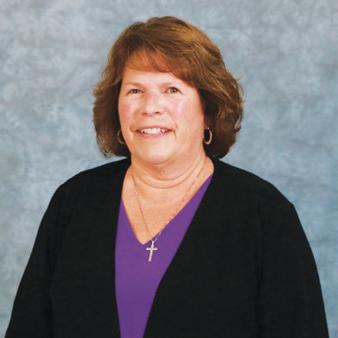
DISTRICT 7
Congress Township in Wayne County and Jackson Township in Ashland County



We are excited to welcome Cody Woods, who is joining our team as the new staff accountant, as we prepare for a year-end retirement in the accounting department. Cody is a graduate of West Holmes High School and Ashland University. We’re confident Cody’s skills and experience will be a great asset to the HWEC team!
HWEC Lineman Steve Asbury was one of five cooperative lineworkers in Ohio selected to attend this safety and leadership summit.
Seventy lineworkers across the nation are bringing shared developed skills back to their cooperatives to continue advancement in the safety culture.
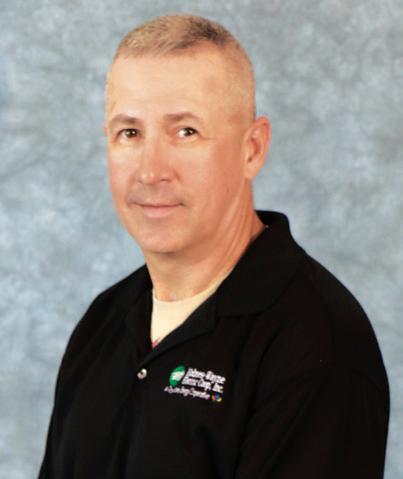


Congratulations to Lydia Hassenzahl of Burbank! Ohio’s Electrical Cooperatives awarded two students in the state of Ohio Trade School Scholarships, and HWEC member Lydia was a recipient!
Report an outage, submit a meter reading, and pay your bill all through our mobile SmartHub application.
Available for both Android and Apple devices
CALL US 24/7

Report outages, submit meter readings, and make payments
Text an outage to 55050 with the word “outage.”

Your body’s temperature is regulated by water.

Shouldn’t your home’s temperature be regulated by water?

The comfort of radiant meets the efficiency of geothermal
Geothermal heat pumps circulate water underground to provide the ultimate in energy-efficient heating and air conditioning. Radiant systems circulate water throughout your floors to provide the ultimate in luxurious comfort. WaterFurnace’s new HydroLogic radiant panel married to our 5 Series OptiHeat unit is simply the easiest way to combine the two worlds. You’ll love your warm, toasty floors—and you’ll adore your utility bill. Contact your local WaterFurnace dealer today to learn more. The Earth’s temperature is regulated by water.

The gangly harvestmen are about to emerge from hiding to get ready for the long winter.
BY CRAIG SPRINGER
The month of August is like an early Thursday morning of a given week: Just as Thursday means the week’s coming to a close, August marks the waning of summer. Goldenrod flowers glow in fallow fields, and if you pay it mind, you will feel the first breath of autumn by month’s end.
Daddy longlegs have noticed; come August, the gangly guys and gals have procreation in mind, and begin to gather en masse to mate and prepare to overwinter. Sometimes you’ll find them in aggregations of a few to a few hundred individuals, which helps ensure a greater likelihood of both successful breeding and making it through winter.
That’s why they are also known as harvestmen — for their gregarious nature at harvest time. They live throughout Ohio, on the farm, in the forest, in the suburbs, in your gardens, and in every corner of every city. And they are good to have around.
But first, here is what they are not: Even though they’re also known as shepherd spiders, daddy longlegs are not spiders. Bug scientists, otherwise known as entomologists, put them in the order Opiliones, which comes from the Latin term for “shepherd,” so named because they resemble shepherds of old who used stilts to rise over their flocks and keep a lookout. Spiders are in the order Araneae. More on that later.
Daddy longlegs are mostly that: long legs. They have a pill-like body that rises well above the ground, lifted by eight stilt-like legs. And those legs are for more than just walking: They are sensory organs — a combination of smell and touch and transportation, all in one.
The legs are also essential for defense, but not the way you might think. Your common garden-variety spiders can make tracks, fast, when threatened, which of course is an

effective defense mechanism. Not so for daddy longlegs — they just sort of mosey along. When attacked by a predator such as a bird or a cat (or a spider), they shed a leg. The discarded legs are preprogrammed to wiggle and tremble for maybe as long as an hour, to confuse and throw off the would-be predator while the daddy longlegs ambles on its remaining legs to the shelter of a woodpile or leaf duff. Next time you see a daddy longlegs, take note as to how many legs are missing; the appendages do not grow back. Daddy longlegs may also bob and weave and quiver in the face of a predator, and they throw off a noxious odor.
More differences: While genuine spiders use fangs to inject their prey with toxic venom, daddy longlegs do not produce venom, nor do they have fangs. Instead, they secrete tiny globs of glue to secure live prey, then rip and shred their food, and they are fastidious about it. While spiders weave webs for capturing their prey (araneae is Latin for “a spider’s web”), daddy longlegs lack the talent and the silk glands for such work. Daddy longlegs graze along, eating flower pollen, animal dung, stink bugs, mites, beetle larvae, caterpillars, aphids, and grasshoppers. After meals, they’re known to clean their forelegs by raking their appendages through their mouth.
One more difference between spiders and daddy longlegs: the eyes. Spiders possess acute vision, as they should, having eight eyes. Daddy longlegs have only two eyes, and even those, the entomologists posit, exist mostly to discern light and shadow. It is, after all, through the wafting of legs in the air that daddy longlegs find their way, rather than by sight.
And, oh, by the way, that direction-finding dance may be good for another thing: If you happen to lose a cow, lore has it those waving legs will guide you toward your missing bovine.



The Buckeye State offers a variety of open-water diving experiences.
BY JODI BORGER
Ohio might not be the first place that comes to mind for scuba diving, but with Lake Erie and numerous former quarries turned dive sites, the state has developed a solid reputation among enthusiasts. For Rich Synowiec, it’s become his life’s work.


Rich Synowiec took his first breath underwater in 1979, when he was 10 years old. Later, when he needed a summer job in 1988, he started working as a stock boy at a diving school and quickly took the opportunity to become a certified diver.

As it turned out, that summer job would eventually become his career. He became a certified scuba instructor in 1990 and began managing dive shops almost right away. He soon purchased Divers Incorporated and in 2007, took over as scuba concession contractor for White Star Quarry in Gibsonburg, in Sandusky County.
“I was going through college and never finding exactly what I really wanted to do,” Synowiec says. “I was an early entrepreneurial spirit and I wanted to do something that I would love to do — not necessarily something I would make a million dollars doing, but I never wanted to hate my job.”
For decades, quarries around the country provided the building blocks of the cities they served. Over the past half-century, as quarry operations gradually ceased, those leftover deep pits almost immediately filled with water. It wasn’t long before scuba divers noticed what had become ideal settings for their hobby, and soon enough, began to see their recreational potential. White Star Quarry, for example, offers a unique experience that attracts divers from throughout the Midwest.
Divers can explore sunken boats, vehicles, and various structures placed to create an engaging underwater landscape, and the quarry is home to a variety of freshwater fish species including bass, bluegill, catfish, and koi.
One of its most appealing features, however, is its water clarity. Visibility can range from 30 to 50 feet on a good day, making it an ideal spot for underwater exploration. The quarry’s maximum depth reaches about 75 feet, with plenty of shallow areas for novice divers and deeper sections for those seeking more of a challenge.
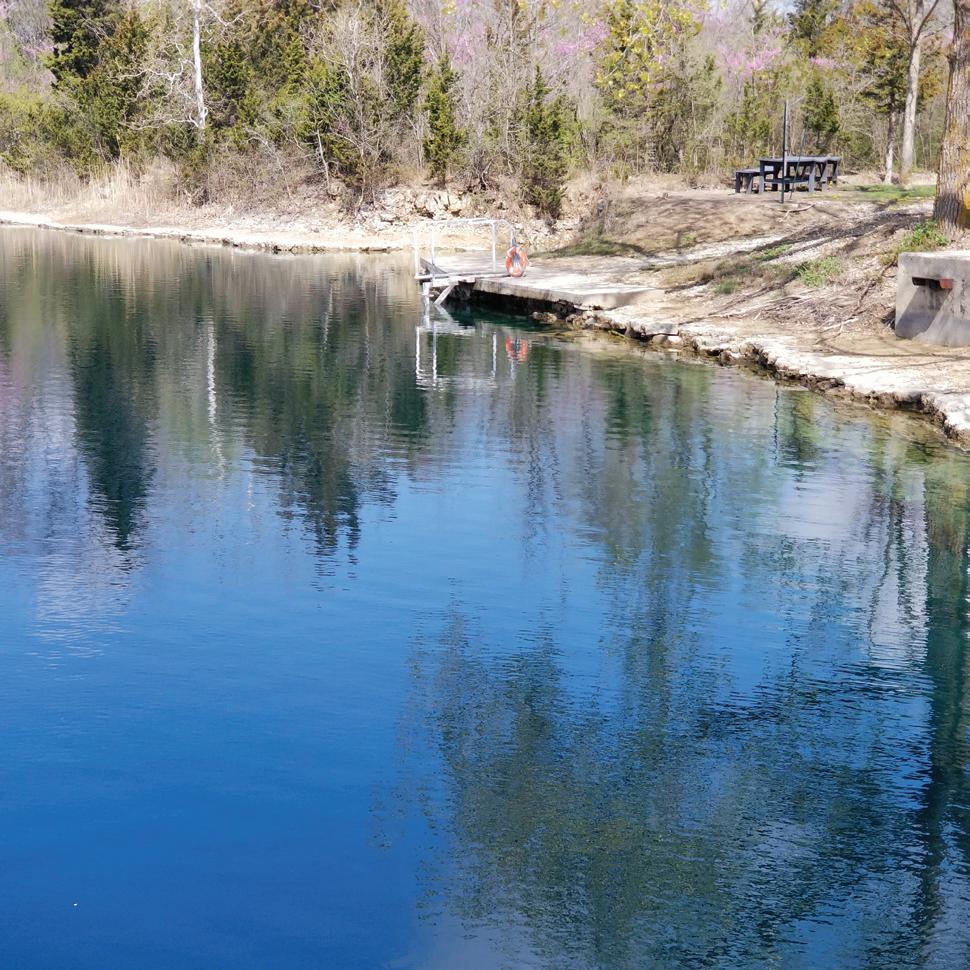



“Every single person on the planet should try scuba diving.”
Synowiec’s on-site dive shop offers rental gear, air fills, and a range of diving accessories. Several local dive trainers conduct classes and certification courses on-site, providing a safe and controlled setting for learning the basics or advancing skills.
In his position today, Synowiec says he sees a gap in the demographic for scuba diving, typically between the ages of 20 and 40, likely because of when divers begin to have families. However, he encourages young people to bring their families out to enjoy the surrounding park’s numerous on-shore amenities.
White Star Park offers a range of recreational activities, including hiking, fishing, and picnicking. Families and guests can enjoy the scenic beauty of the park while divers explore the underwater world.
“White Star Park is a really family-oriented park that has diving as just one of its opportunities,” Synowiec says. “Diving only takes an hour, but there are so many other areas to explore.”
Whether you’re a seasoned diver or just starting, this unique diving destination in Ohio offers a memorable experience with its clear waters, intriguing underwater attractions, and aquatic life.
Synowiec is now married with two daughters, and diving has become a family affair over the years. Meanwhile, Synowiec admits his own parents still wonder when he’ll get his “real job,” but 34 years later, he still loves what he gets to do every day.
“Every single person on the planet should try scuba diving,” Synowiec says. “They get over the fear of being underwater because they are replacing fear with knowledge. They are replacing apprehension with skill. They are replacing timidity with perseverance. And when you look at that kind of a level of what people are able to do, it becomes something spectacular.”
A selection of other spots around Ohio to scuba dive:
3763 Old State Route 224, Ottawa, 45875
• Maximum depth: 120 feet
• Average visibility: 26–30 feet
• Attractions: Underwater private jet, helicopter, tower wreck, rainbow trout, paddlefish, and an underwater wall for rappelling to depths below 100 feet.
1500 Mt. Vernon Road, Newark, 43055
• Maximum depth: 31–35 feet
• Average visibility: 5–10 feet
• Attractions: Paddlefish, catfish, albino catfish, bluegill, bass, and some fresh water clams. There are sunken boats, an ambulance, a bathtub, a toilet, various skeletons, an underwater platform, and more.
2715 Sugar Grove Road SE, Lancaster, 43130
• Maximum depth: 60 feet
• Visibility: 10–30 feet, depending on weather




• Attractions: A tranquil scuba diving experience in a 16-acre, reasonably deep spring-fed quarry. Many underwater attractions — twin engine airplane, Frito Lay truck, car, boat, weed bed reef, etc. — are strategically placed at various points throughout the lake.
206 South Washington Street, New Paris, 45347
• Maximum depth: 40 feet
• Average visibility: 11–15 feet
• Attractions: Variety of wildlife including bass, catfish, freshwater jellyfish, and grass carp over 4 feet long; several sunken cars and boats.
• Lake Erie is a vast dive site rich in history, ideal for experienced divers to explore its many shipwrecks. Many dive shops around the state offer diving excursions.
• Numerous Ohio state parks allow scuba diving in various lakes, as long as divers check in advance with the individual parks. Visibility at most, however, is limited.
Big Muskie’s giant bucket is all that remains from a bygone era of strip mining in eastern Ohio.
Mentioned in most places, it will set an angler’s heart racing — but mention “Big Muskie” in southeast Ohio and it’s likely to bring on intense memories, curiosity, or the warm and fuzzy feeling that at one time, right here in Ohio, the largest dragline excavator the Earth has ever known operated for the Central Ohio Coal Company.
“I felt so blessed to run all that equipment,” says John Paul Reed, of Waterford, who says he ran all kinds of heavy equipment for the Central Ohio Coal Company back in the day. But Big Muskie, also known as the 4250 dragline, was the top of the heap. “If anybody ever finds out you worked with Big Muskie, they have all kinds of questions.”
The massive machine was constructed by the BucyrusErie Company. It stood more than 222 feet tall, its boom reaching out 310 feet, and it moved at a blistering pace of about 9 feet per hour. Big Muskie was constructed on-site in Morgan County — it took 340 rail cars and 260 trucks to ship all its components, followed by more than 200,000 man-hours to assemble. It weighed 27 million pounds and cost $25 million ($200 million today), and operated for 22 years — from 1969 until 1991.
In total, the machine moved about 608 million cubic yards of material at the coal mine. But it never moved coal, which is something most people don’t realize. Big Muskie scooped away dirt and stone, called overburden, so that smaller machines could come in and scoop coal from the seams.



According to Reed, the coal seams could be as much as 140 feet or more beneath the surface and could run anywhere from 18 inches to 3 or 4 feet thick. After the smaller excavators removed the coal, Big Muskie and its crew replaced the overburden where it had been.
Reed was an all-around company guy, running massive bulldozers, pumping water from ponds, and anything else needed — including keeping Big Muskie’s components well-oiled. That included the 330-foot twin booms.
“When it shut down, we’d climb the boom and make sure everything was OK,” he says. “Make sure the lines were greasing and there were no broken lines and everything was getting properly lubed so you wouldn’t have a bearing go out.”
It took seven men to make Big Muskie work: an operator, two oilers, two dozers, a welder, and an electrician — and more help was available if needed. One of those electricians was McConnelsville resident Dave Bailey, who worked on Big Muskie for a decade.
“I was on it until the very last day it operated,” he says, wistful pride in his voice. “I worked on anything that had to do with the electrical systems. And most people don’t know it, but Big Muskie ran on electric. It took about twothirds the power of Las Vegas. We were highly trained and certified by the federal government.”
Like Reed, Bailey says that when folks find out he worked on Big Muskie, they've got questions.
Opposite page: Big Muskie works the strip mine in southeast Ohio during the heyday of coal in the region (photograph courtesy of Ohio Department of Natural Resources).
All that remains of Big Muskie, besides memories, is her bucket, on display at Miner's Memorial Park near McConnelsville (photograph by James Proffitt).


Impromptu memorials that often pop up after a tragedy comfort the grieving and help folks remember to drive with care.
STORY AND PHOTOGRAPHS BY JAMES PROFFITT
In February 2022, a crash on Ohio 19 in Ottawa County took the life of Shannon Roberts’ 17-year-old son, Richie, and his friend, who was driving. “He was a great kid and didn’t deserve what happened,” she says. “It was a complete accident and nobody’s to blame.”
Rocked with grief and not knowing really what else to do, she decided to put up a memorial — a taller cross and two smaller ones on either side, with photos of her son and his friend and a small collection of items left by friends, family, and the community. The memorial isn’t at the exact site where the crash occurred, though very near, about 15 feet off the roadway. “It was better and safer to have it where it is now,” she says. “And we got permission from the landowner to put it up.”
Drivers in Ohio pass them by, often without a second thought — a small cross or a bouquet of flowers, a candle or a stuffed animal, any of a number of seemingly insignificant trinkets. But to the folks who have erected these roadside memorials, they mean the world.
“There’s a sense of honor and respect” to them, says Matt Bruning, a spokesman for the Ohio Department of Transportation. It’s unfortunate, to say the least, but in Ohio more than 1,000 people a year die in traffic crashes. Most folks who set out to honor loved ones lost on the roadside don’t check with ODOT first; they just do what feels right.
Officially, roadside memorials on ODOT rights-of-way are illegal. In fact, anything placed on those rights-of-way requires a permit — and the state does not issue such permits. But it doesn’t get a lot of enforcement attention from state officials. In fact, season after season, ODOT workers dutifully mow around memorials, and generally they’re not disturbed. Bruning says ODOT doesn’t track the number or location of the impromptu shrines, and to his knowledge, no one has ever been cited for erecting one.




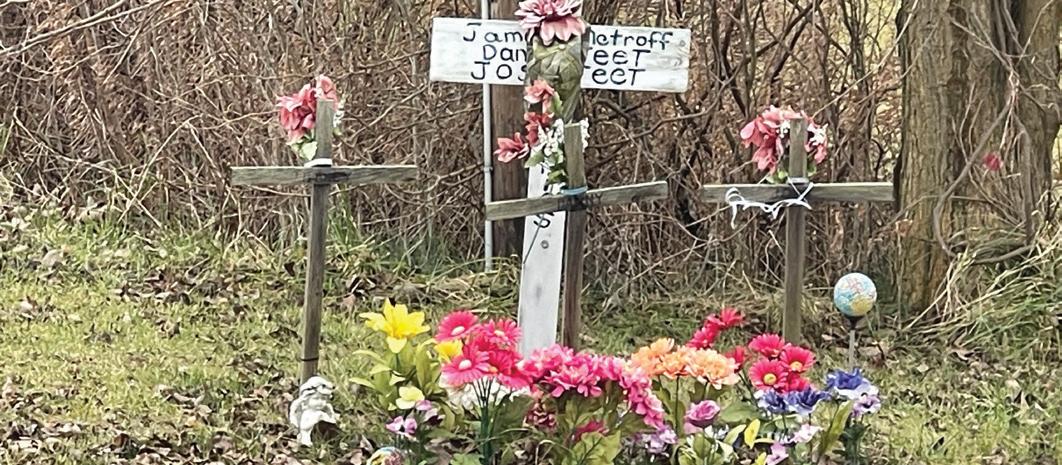
“But at the same time, we have to keep safety in mind and the ability to do our jobs,” Bruning says. “They can become a hazard and our crews have to maintain the roadsides around them. If we ever do have to take action, we’ll take that roadside memorial back to our closest garage and make every effort we can to find the person responsible so we can return it to them, and hopefully they can find another way of doing it.”
So it’s a subtle truce: ODOT safety concerns and respect for the grief of Ohio families coexist with unobtrusive crosses and mementos of those lost tragically on the state’s roadways. “I guess one thing I would add is that when we do take down a roadside memorial, it’s not from a place of disrespect,” he says. “It’s just that safety is our No. 1 priority.”
Roberts says she never really noticed roadside memorials, or thought much about them, before the accident. But that’s all changed now. “I feel like I see a lot of them everywhere now,” she says. “Honestly, I think the bigger the better. Anything to bring awareness to safety and stupidity all at the same time.”
Roberts lives in nearby Fremont and drives by her son’s memorial often.
“We’ll go out there, hold our memorial at the site,” she says. “We do see new flowers or rocks and a picture here or there. We don’t have a set time limit on it, but I’d like to keep it up and keep some kind of awareness going on. Especially for young kids and everyone driving who’s not taking into consideration it’s not just their own lives, but that everyone else on the road is in your hands, too.”
The State of Ohio offers a way to more permanently honor someone’s memory rather than erecting homemade roadside memorials.
The Adopt-a-Highway Litter Program is a safe, useful — and legal — way to honor someone killed in a crash. The program allows people to “adopt” a mile of state highway by collecting trash there four times a year. Friends and relatives can get together and reminisce while they accomplish something positive. The state provides trash
bags, grabbers, and disposal of collected trash along that stretch of road. ODOT will then erect an official highway sign in memory of that loved one. “I wish people would just keep their trash inside their vehicles, but unfortunately, they don’t, and taxpayers spend millions a year to deal with it,” says Matt Bruning of ODOT. “This is a safe way to both impact the problem and to memorialize a loved one.”
For information, visit https://www.transportation.ohio. gov/programs/adopt-a-highway.


















THROUGH SEP. 15 – NWORRP Museum Summer Hours, Northwest Ohio Railroad Preservation Inc., 12505 Co. Rd. 99, Findlay, Sat./Sun. 1–4 p.m. $3; 12 and under, $2 (includes 1 train ride ticket per admission). Museum tours, quarter-scale train rides, model train displays, games, play area, and more. 419-423-2995, www. nworrp.org, or www.facebook.com/nworrp.
THROUGH OCT. 12 – The Great Sidney Farmer’s Market, 109 S. Ohio Ave., every Sat. 8 a.m.–noon. Vendors from all around the area provide great food, crafts, and more! 937-658-6945 or www.sidneyalive.org.
AUG. 7, SEP. 4 – Down on the Farm Story Time, Proving Ground Farm, 5670 E. Twp. Rd. 138, Tiffin, 10 a.m. Stories and activities are geared for preschoolage children and focus on farming and nature in a picturesque outdoor setting. Families welcome! 419447-7073, www.conservesenecacounty.com, or follow Seneca Conservation District on Facebook.
AUG. 10–11, SEP. 7–8 – Findlay Flea Market, Hancock Co. Fgds., 1017 E. Sandusky St., Findlay, Sat. 9 a.m.–4 p.m., Sun. 9 a.m.–3 p.m. Free admission. Variety of merchandise: new, used, vintage items, crafts, and more. Vendors welcome! Contact Christine at 419-619-0041 or findlayfleamarket@gmail.com for more information.
AUG. 15–17 – Bucyrus Bratwurst Festival, downtown Bucyrus. Grilled brats and other festival foods, parades, craft and art show, rides, games, and free entertainment. 419-562-2728 or www.bucyrusbratwurstfestival.com.
AUG. 18 – NW Ohio Low Brass Collective Summer Concert, Allen East High School Auditeria, 9105 Harding Hwy., Harrod, 4 p.m. Free and open to the public. Come hear musicians from around northwest Ohio and beyond play classical tunes. www.facebook.com/people/NWOhio-Low-Brass-Collective/100085554007401
AUG. 18 – Sunset Jazz and Art Festival, on the Towpath Trail, Grand Rapids, 2 p.m. to dusk. Free admission. Art, food. and beverages for purchase. Bring lawn chairs. NO coolers. www.grandrapidsartscouncil.org.
AUG. 18 – West Central Ohio Community Concert Band, Piatt Castle Mac-A-Cheek, 10051 Township Rd. 47, West Liberty, 6 p.m. Free. Bring chairs or blankets for this outdoor lawn concert. www.piattcastle.org.
AUG. 22 – Fourth Thursdays Back to School, downtown Lakeview. Bring your family and friends downtown for dinner and live music while you purchase the latest school supplies on your list from each local business. Collect your Shopping Passport stamps for an additional chance to win. www.facebook.com/ downtownlakeviewohio.
AUG. 24–25 – Family Fun Weekend: “Back to School Bash,” Northwest Ohio Railroad Preservation Inc., 12505 Co. Rd. 99, Findlay, 1–4 p.m. $5. Games, quarter-scale train rides, bounce house, and other family-friendly activities and events. 419-423-2995, www.nworrp.org, or www.facebook.com/nworrp.
AUG. 30–SEPT. 1 – Perch, Peach, Pierogi, and Polka Festival, downtown Port Clinton, Fri. 4–9:30 p.m., Sat./ Sun. 11 a.m.–9:30 p.m. $8/day, $20/weekend, under 18 free. Lake Erie yellow perch sandwiches and dinners,
AUG. 30–SEP. 1 – Labor Day Celebration, Oglebay, 465 Lodge Dr., Wheeling. Live entertainment, face painting, balloon art, inflatable fun zone, Revolutionary War battle reenactments, a woodcarver’s show, skydiving performance, music, and an unforgettable fireworks display. 877-436-1797, whodorowski@ oglebay.com, or www.oglebay.com.
pierogis, Polish sausage, peach pie and ice cream, and polka music! Free polka lessons Sat. and Sun. at 4 p.m. 419-341-9226 or www.kofc1750.org.
AUG. 30–SEP. 2 – Labor Day Festival, 576 Township Rd. 174, West Liberty. Enjoy a fun-filled weekend at Lions Park! Flea market, vendors, and food trucks. See antique tractors in all their glory as they parade through the streets of the village. www.mywestliberty.com.
AUG. 30–SEPT. 5 – Fulton County Fair, Fulton Co. Fgds., 8514 St. Rte. 108, Wauseon. www.fultoncountyfair.com.
SEP. 6 – Art, Wine, and Jazz Festival, downtown Bellefontaine. Walk from store to store sipping samples of Ohio-made wine and exploring different pieces of art from local artists. www.firstfridaysbellefontaine.com.
SEP. 7 – Hobo Dinner, AuGlaize Village, 12296 Krouse Rd., Defiance, 4 p.m. Donation is $20. Fundraising event. A delicious Hobo Stew will be prepared in a huge kettle over an open fire and served with bread and butter and a selection of desserts. Beverages provided. Purchase tickets in advance. 419-990-0107, villageauglaize@gmail. com, or www.auglaizevillage.com.
SEP. 7 – Napoleon Fall Festival and Car Show, Henry Co. Fgds., St. Rte. 108 S., Napoleon, 10 a.m.–4 p.m. Food trucks, crafts, swap meet, kids’ games, and more. Car and truck show judged by River City Rodders Car Club, with awards at 3 p.m. For more information, call 419-265-4605
SEP. 8 – Findlay Fall Model Train Show, Northwest Ohio Railroad Preservation Inc., 12505 Co. Rd. 99, Findlay, 10 a.m.–3 p.m. $5; 12 and under accompanied by an adult will be free. Model trains, toy trains, and railroad memorabilia. Quarter-scale train rides: $3 adults, $2 children. 419-423-2995, www.nworrp.org, or www.facebook.com/nworrp.
AUG. 30–SEP. 1 – West Virginia Italian Heritage Festival, West Main Street, Clarksburg, 8 a.m.–8 p.m. Wide array of authentic Italian “street food,” complete with pastries; entertainment for all ages; carnival midway with rides and games; and much more. 304622-7314, wvihf@wvihf.com, or www.wvihf.com.
AT LEAST 90 DAYS prior to the event, send an email to events@ohioec.org, or mail your information* to:
Ohio Cooperative Living 6677 Busch Blvd. Columbus, OH 43229
* Make sure to include all contact information! Ohio Cooperative Living will not publish listings that don’t include a complete address, phone number, or website for more information.

the last Sunday of each month, see how corn was ground 200 years ago. 614-321-4833 ext. 103 or www. fairfieldcountyparks.org/events.
AUG. 2, SEP. 6 – First Friday Art Walk, downtown Zanesville, 5–8 p.m. Come downtown on the first Friday of each month, when all our participating galleries, studios, and small businesses are open at the same time! Visit the Artist Colony of Zanesville’s website for a map of current participants: https://artcoz.org/arts-district-map.
AUG. 17 – Columbus Food Truck Festival, Franklin Co. Fgds., 4100 Columbia St., Hilliard, 11 a.m.–10 p.m. $5 advance, $10 at the door; 12 and under free. Fifty of the best food trucks in Ohio, along with live music, handcrafted items from local artisans/crafters, and shopping at the Columbus Vintage Exchange. www. columbusfoodtruckfest.com.
THROUGH AUG. 25 – CAPA Summer Movie Series, Ohio Theatre, 55 E. State St., Columbus, Wed.–Sun. 7:30 p.m., Sun. matinee 2 p.m., “Cartoon Capers” Sat. 10 a.m. Series showcasing classic films and cult movies. 614-4690939 or www.capa.com.
THROUGH SEP. 28 – Sunbury Farmers Market, 36 Cherry St., on the Square of Sunbury, 9 a.m.–1 p.m. Offering local products — handmade, homemade, or homegrown. Vendors welcome. 740-513-9192 or sunburyohiofarmersmarket@gmail.com.
THROUGH OCT. 26 – Coshocton Farmers Market, 22442 Co. Rd. 1A, Coshocton, Sat. 8:30 a.m.–noon. Fresh, locally grown, in-season produce; baked goods; and handmade artisan crafts. For up-to-date information about vendors who will be attending the market, visit www.facebook.com/coshoctonfarmersmarket or email market.manager@coshfarmmarket.org.
THROUGH OCT. 27 – Rock Mill Days, Stebelton Park at Rock Mill, 1429 Rockmill Place NW, Lancaster, Wed./ Sat. 11 a.m.–2 p.m., Sun. 1–4 p.m. Tour the restored 1824 gristmill, walk the covered bridge, and view the waterfall near the headwaters of the Hocking River. On
THROUGH SEP. 1 – Tecumseh! Outdoor Drama, Sugarloaf Mountain Amphitheatre, 5968 Marietta Rd., Chillicothe, 8 p.m. $30–$50. Witness the epic life story of the legendary Shawnee leader as he defends his sacred homelands in the Ohio country during the late 1700s. www.tecumsehdrama.com.
THROUGH NOV. 2 – Athens Farmers Market, Athens Community Center, 701 E. State St., Athens, Wed. 9 a.m.–noon. Open year-round Sat. 9 a.m.–noon. Voted Ohio’s #1 favorite farmers market! 740-593-6763 or www. athensfarmersmarket.org.
AUG. 17 – Cambridge Main Street Classic Car Show, Wheeling Avenue, Cambridge, 9 a.m.–5 p.m. One of the longest-running car shows in the area, with close to 300 entries. Author/journalist Jimmy Dinsmore will be
AUG. 8, SEP. 12 – Inventors Network Meetings, Rusty Bucket, 3901 Britton Parkway, Hilliard, 43026 (614-7775868, MyRustyBucket.com), 7 p.m. Informal meetings for networking and invention-related discussion. 614-4700144 or www.inventorscolumbus.com.
AUG. 9–10 – Carroll Community Festival, Bessie Benson Park, Center Street, Carroll. www. carrollareahistoricalsociety.weebly.com.
AUG. 9–11 – Coshocton Sunflower Festival, Coshocton KOA, 24688 Co. Rd. 10, Coshocton, Fri. 12–7 p.m., Sat. 10 a.m.–7 p.m., Sun. 10 a.m.–5 p.m. Purchase tickets online. Over 50 varieties of sunflowers, wagon ride to the field, live music, food trucks, wine and beer garden, and craft vendors. 740-502-9245 or www. coshoctonsunflowerfestival.com.
AUG. 11–17 – Muskingum County Fair, Muskingum Co. Fgds., 1300 Pershing Rd., Zanesville. Information and schedule available at www.muskingumcofair.com.
AUG. 16–18 – Fairfield County Antique Tractor Club Truck, Tractor, and Toy Show, Fairfield Co. Fgds., 157 E. Fair Ave., Lancaster. Feature tractor is Case. Field demos, hit-and-miss engines, steam engines, sawmill, tractor pulls, and more. 740-407-2347 (Doug Shaw), dstractorlover@sbcglobal.net, www. fairfieldcountyantique tractorclub.com, or follow Fairfield Antique Tractor Club on Facebook.
speaking at 1 p.m. Food and entertainment throughout the day. www.facebook.com/events/2060171497709441
AUG. 18 – Annual Rod Run and Car Show, Yoctangee Park, downtown Chillicothe, 9 a.m. Free. Top 50 awards and specialty awards. Schmidt’s Sausage Truck will be on-site; also games, door prizes, cash drawings, raffles, and music. www.downtowncambridge.com.
AUG. 23 – BeachFest, Paint Street, downtown Chillicothe, 7:30–10:30 p.m. Free. Before the Sands in the Streets volleyball tournament, enjoy an evening of beachside fun in our downtown with live music from 20 Ride, a Zac Brown tribute band. Sand toys available for children. www.downtownchillicothe.com.
AUG. 24 – Sands in the Streets, Paint Street, Chillicothe, 10 a.m.–8 p.m. Free. We unload 300 tons of sand on the streets of downtown Chillicothe to welcome volleyball teams and spectators back for a day of competition and fun, with 8 semi-professional, 8 competitive, and 16 recreational teams. www.downtownchillicothe.com.
AUG. 31 – Bark in the Park, Yoctangee Park, Chillicothe, 9 am.–3 p.m. Free. Presented by the Ross County Humane Society, this car and bike show is open to all makes, models, and years ($25 registration). DJ, 50/50 raffle, food, door prizes, and trophies for the Top 35 www.downtownchillicothe.com.
SEP. 2–8 – Belmont County Fair, Belmont Co. Fgds., 45420 Roscoe Rd., St. Clairsville. General admission $10 A family tradition since 1849. www.belmontcountyfair.org.
AUG. 30–SEP. 1 – Coshocton Flint Festival/Flint Ridge Knap-In, Coshocton Co. Fgds., 724 S. 7th St., Coshocton, 9 a.m.–5 p.m. Ancient art of chipping arrowhead, other native crafts, gems, handmade items, entertainment, and family fun! 330-473-7041 or 419-6321274
SEP. 5–7 – Marion Popcorn Festival, downtown Marion, 11 a.m.–midnight. Free admission. Parade Thur. 6 p.m. Concerts, rides, games, arts and crafts, entertainment, food, and, of course, popcorn for all! 740-387-FEST (3378) or www.popcornfestival.com.
SEP. 6–7 – Lithopolis Honeyfest, Columbus St., Lithopolis, Fri. 3–7 p.m., Sat. 10 a.m.–7 p.m. Honey tasting, honey bake-off and bake sale, beekeeping demos and education, honey competition, arts and crafts exhibitors, mead garden, and much more. 614-769-3824 or www.lithopolishoneyfest.com.
SEP. 10, 17 – Friendly Ties Square Dance Club Lessons, Pickerington Senior Center, 150 Hereford Dr., Pickerington, 7–9 p.m. First two lessons are free; $5/ person per class after Sep. 17. Come join in the fun and reap the benefits — physically, mentally, and emotionally. 614-316-5838 or www.friendlyties.org.
SEP. 14 – Battle of the Bands, Circleville Eagles, 135 E. Main St., Circleville, 7–11 p.m. $5. Outdoor concert with food vendors and drinks. www.pickaway.com.
SEP. 6–8 – Ohio River Sternwheel Festival, Front and Greene Sts., Marietta. Sternwheeler races, car show, pageant, 5K run, entertainment, food, and fireworks. 740-373-5178 or www.sternwheel.org.
SEP. 7 – Phil Dirt and the Dozers, Monroe Theatre, 104 N. Main St., Woodsfield, 7 p.m. Starting at $25 866-537-0413, www.monroetheatretickets.com, www. historicmonroetheatre.com, or find The Monroe Theatre on Facebook.
SEP. 7 – YOTĒ, Tar Hollow State Park, 16396 Tar Hollow Rd., Laurelville, 8 a.m. $40–$99. Single-loop course of primarily single-track trail with some bridle trail and forest roads mixed in. Distance options of 50K/25K/5M. Cash prize to top male and female of each distance, top 3 male and female overall awards. https://ultrasignup.com/ register.aspx?did=113085
SEP. 9–15 – Guernsey County Fair, Guernsey Co. Fgds., Old Washington. 740-489-5888 or www. guernseycountyfairgrounds.org.
SEP. 13–15 – Ohio Pawpaw Festival, Lake Snowden, 5900 U.S. 50, Albany. Fun-filled and educational community event celebrating one of America’s largest native tree fruits, with food, entertainment, contests, arts and crafts, and much more. pawpawfest@gmail. com, www.ohiopawpawfest.com, or www.facebook.com/ share/6bef3anBLQQGHS3A/?mibextid=eQY6cl.
THROUGH AUG. 29 – Kayak Excursion, Hueston Woods State Park, 6301 Park Office Rd., College Corner, Thur. 1 p.m. Meet at the Nature Center to learn kayaking basics and then take a guided trip on Acton Lake. Space is limited; signup begins Thur. 9 a.m. at the Nature Center. www.ohiodnr.gov/go-and-do/plan-a-visit/find-a-property/ hueston-woods-state-park.
THROUGH AUG. 30 – Night Hikes, Hueston Woods State Park, 6301 Park Office Rd., College Corner, Fri. 9:30 p.m. Meet at the Indian Mound in the campground for a nighttime adventure. Please wear appropriate footwear. www.ohiodnr.gov/go-and-do/plan-a-visit/find-a-property/ hueston-woods-state-park.
THROUGH AUG. 31 – Orienteering, Hueston Woods State Park, 6301 Park Office Rd., College Corner, Fri. 5 p.m. Meet at the Nature Center to learn to navigate with a map and compass. We will be off trail; long pants are recommended. www.ohiodnr.gov/go-and-do/plan-a-visit/ find-a-property/hueston-woods-state-park.
THROUGH SEP. 25 – Bluegrass Wednesdays, Vinoklet Winery, 11069 Colerain Ave., Cincinnati, Wed.
THROUGH SEP. 1 – Steubenville Catfish Crawl, downtown Steubenville. Ten 5-foot-long, intricately painted fiberglass catfish will be on display around the downtown. Grab a map and find them all! Maps available at Leonardo’s Coffeehouse, 159 N. 4th St. www.steubenvillenutcrackervillage.com/catfish.html.
AUG. 9–OCT. 12 – Plant and Animal Fiber Exhibit, McCook House Museum, 15 S. Lisbon St., Carrollton, Fri./Sat. 10 a.m.–5 p.m. $3. See a variety of handmade items from local crafters including baskets, rush, reed, caned bottom chairs, woven rugs, wall hangings, knitted and crocheted items, and much more. 330-437-9715 or kathorn4120@gmail.com.
AUG. 10–11, 17–18, 24–25 – Shaker Woods Festival, 44337 County Line Rd., Columbiana, 9 a.m.–5 p.m. Over 200 crafters and artisans dressed in Shaker period clothing will demonstrate and sell their handmade wares. www.shakerwoods.com.
AUG. 16 – Grady Miller: Blues, Americana, Country, and Bluegrass, John Streeter Garden Amphitheater, 2122 Williams Rd., Wooster, 6:30 p.m. Free, but registration recommended. The Akron-based duo of Cathy and Michael Grady will perform their thoughtfully crafted original music. In the event of rain, the concert will be held at Fisher Auditorium, 1680 Madison Ave. 419853-6016 or www.ormaco.org.
6:30–8:30 p.m. Enjoy dinner, wine, and an evening of free entertainment by Vernon McIntyre’s Appalachian Grass. Reservations recommended. 513-385-9309, vinokletwinery@fuse.net, or www.vinokletwines.com.
AUG. 16, SEP. 20 – Bluegrass Night, Fibonacci Brewing Company, 1445 Compton Rd., Cincinnati, 7–9 p.m. Free. Enjoy lively bluegrass music by Vernon McIntyre’s Appalachian Grass, a wide variety of craft beers at the Beer Garden, and food truck eats. 513-832-1422 or http://fibbrew.com.
AUG. 16–24 – The Great Darke County Fair, Darke Co. Fgds., 800 Sweltzer St., Greenville. $7, under 12 free. $25 for 9-day pass. 937-548-5044, contact@darkecountyfair. com, or www.darkecountyfair.com.
AUG. 17 – Family Program: WildLife Excursion, Wild Hearts African Farm, 7010 Jordan Rd., Lewisburg, 11 a.m. Free. Led by Amanda Badger. Registration required. 937962-5561, pcpdevents@gmail.com, or www.preblecountyparks.org.
AUG. 24 – The Tour De Donut, downtown Troy. A fun, unique bicycle event, where your ability to eat donuts is just as important as your ability to ride your bicycle fast! Kick off the weekend on Aug. 23 with the Donut Jam in downtown Troy, 5–10:30 p.m. www.thetourdedonut.com.
AUG. 30–SEP. 1 – Oktoberfest, 2361 Hamilton-Cleves Rd. (Rte. 128), Hamilton, Fri. 6–10 p.m., Sat. 1–11 p.m., Sun. 1–8 p.m. Oldest Oktoberfest in the tri-state area. Authentic German food, wiener dog races, live music, and much more. Car show Sun. 12–4 p.m. www. www. libertyhome.net or go to the Liberty Home Association page on Facebook.
SEP. 5 – Vernon McIntyre’s Appalachian Grass, Harry T. Wilkes Conference Center, 1601 University Blvd., Hamilton, 7 p.m. Free. Presented by Miami University
AUG. 18 – Northern Ohio Doll Mini and Bear Show, Strongsville Best Western, 15471 Royalton Rd., Strongsville, 10 a.m.–3 p.m. ($6; children free), early bird 9 a.m. ($15). Antique, vintage, and modern dolls, bears, and toys; supplies and accessories. Door prizes, ID/ valuation, restringing (fee). Food available for purchase. 440-283-5839 (Eileen Green), phdofdolls@yahoo.com, or www.dollshowUSA.com.
AUG. 18–25 – Lorain County Fair, 23000 Fairgrounds Rd., Wellington. Ohio’s second-largest county fair. 440647-2781 or www.loraincountyfair.com.
AUG. 24 – Jazz under the Stars: Hip to That, Uptown Park, 79–89 Public Square, Medina, 7 p.m. Free. Cleveland-based jazz quartet specializing in tunes from the Great American Songbook, jazz standards, and pop tunes with a jazzy twist. Bring lawn chairs, blankets, and picnics to enjoy this upbeat concert. In the event of rain, the concert will be held at St. Paul’s Episcopal Church, 317 E. Liberty St. 419-853-6016 or www.ormaco.org.
AUG. 24–25, AUG. 31–SEPT. 2 – Great Trail Arts and Crafts Festival, Great Trail Festival Grounds, 6331 Canton Rd., Malvern, 10 a.m.–5 p.m. $5–$7, under 10 free. Celebration of American folk art, with distinctive arts and crafts, living history, live music, clog dancing, tomahawk throwing, and more. 330-794-9100 or www. greattrailfestival.com.
AUG. 30–SEPT. 2 – Firelands Labor Day Festival, New London Recreation Park, 2 Blake St., New London. Truck and tractor pulls, demolition derby, games, rides, vendors, concessions, and more. 419-929-4091 or www. newlondonoh.com/calendar.
AUG. 31–SEP. 1 – Toronto Festival of the Arts, downtown Toronto, Sat. 10 a.m.–6 p.m., Sun. 11 a.m.–5 p.m. Handmade arts and crafts, food, live entertainment. www.focusintoronto.com.
SEP. 6 – First Fridays on Fourth, 155 N. 4th St., Steubenville, 6–10 p.m. Free. Monthly themed
Regionals Appalachian Studies. Enjoy an evening of lively bluegrass music with lightning-fast instrumentals, close harmonies, and entertaining novelty songs. 513-785-3175 (Matthew Smith) or www.facebook.com/ MiamiRegionalsAppStudies.
SEP. 6 – Vernon McIntyre’s Appalachian Grass, Clinton County Corn Festival, 958 Main St., Wilmington, 7–9 p.m. $5 937-417-8488 or https://cornfestivalonline.com.
SEP. 6–8 – Clinton County Corn Festival, Clinton Co. Fgds., 958 W. Main St., Wilmington. $5, under 12 free; weekend pass $10. Featuring Minneapolis-Moline. Corn Olympics, antique tractor pulls, horse pulls, antique cars and trucks, hit and miss engines, steam engines, food, crafts, and more. 937-383-5676 (Dale Mayer) or www.cornfestivalonline.com.
SEP. 14 – 5K Run/Walk/Hike, Garber Nature Center, 9691 OH-503 N., Lewisburg, 9 a.m. $20; 12 and under, $10. Registration required @ Speedy Feet. 937-962-5561, pcpdevents@gmail.com, or www. preblecountyparks.org
SEP. 14 – 2024 Solar Eclipse Presentation, Garber Nature Center, 9691 OH-503 N., Lewisburg, 7:30 p.m. Astronomer Terry Mann. Registration required. 937962-5561, pcpdevents@gmail.com, or www.preblecountyparks.org
SEP. 15 – White Water Shaker Village Tour, 11813 Oxford Rd., Harrison, 2–5 p.m. Free. Established in 1823, White Water is one of the 24 Shaker communal villages founded in the United States. Learn about the daily life of a Shaker; discover the styles of businesses they conducted; and check out our collections of Shaker goods. Explore the property to see the stable, barns, and historic outbuildings of this 200-year-old village. www.whitewatervillage.org.
celebration featuring art, crafts, games, food trucks, live entertainment, and activities to stimulate the imagination. www.theharmoniumproject.org/first-Fridays.
SEP. 7–8 – Antiques in the Woods and Vintage Too, Shaker Woods Grounds, 44337 County Line Rd., Columbiana, Sat. 9 a.m.–4 p.m., Sun. 9 a.m.–3 p.m. Top-quality antiques and collectibles, food, and entertainment. 330-482-0214, www.youngstownlive.com/ event, or follow Antiques in the Woods on Facebook.
SEP. 7–8 – Pioneer Days, Historic Lyme Village, 5001 St. Rte. 4, Bellevue, 10 a.m.–4 p.m. The Village — composed of three log houses, a one-room schoolhouse, log church, blacksmith shop, general store, 1836 farmhouse used by the Underground Railroad, and more — comes alive with costumed reenactors, encampments, and demonstrators. www.lymevillage.org.
SEP. 7–12 – Wayne County Fair, Wayne Co. Fgds., 199 Vancouver St., Wooster, gates open 8 a.m. $4/day. Ohio’s foremost agricultural fair. 330-262-8001 or www. waynecountyfairohio.com.
SEP. 8 – Canton-Akron Comic, Toy, and Nostalgia Convention, St. George Event Center, 4667 Applegrove St., North Canton, 10 a.m.–4 p.m. $5; 6 and under free. Free parking. Comic and toy vendors, guest comic creators, hourly prizes. 330-462-3985, jeff@ harpercomics.com, or www.harpercomics.com.
SEP. 8 – QS Jazz/Qwik Silver: “Songs of Societal Injustice,” Wadsworth Public Library, 132 Broad St., Wadsworth, 2–3 p.m. Free, but registration recommended. 419-853-6016 or www.ormaco.org.
SEP. 9–21 – “Celebrate the Constitution,” Historic Fort Steuben, 120 S. 3rd St., Steubenville, Mon.–Sat. 10 a.m.–4 p.m., Sun. 11 a.m.–4 p.m. Free. Annual exhibit and activities focusing on the nation’s founding document and the issues and personalities of the time. 740-283-1787 or www.oldfortsteuben.com.



1 4 2 5 3 6


1. My granddaughter Evelyn at age 2 (now 5) along with her mother, Madison. She was so proud of herself and having the best time jumping in, then hopping out and repeating!
Diana Aikin, Pioneer Electric Cooperative member.

2. Our son flying from the diving board. Ashley Schumm, North Central Electric Cooperative member.
3. Our granddaughter, Malia Brooks (age 10), showing off her gymnastic skills in her new sport: diving. Cheryl Fortman, Paulding Putnam Electric Cooperative member.

4. This is my granddaughter Addi at her birthday party Denise Loy, Washington Electric Cooperative member.
5. My daughters, Bridgette and Britton, doing what they love — jumping into the pool together!
Carrie Bussing, North Western Electric Cooperative member.
6. Moeller sisters Madison (left) and Abbie going off the diving boards together last summer.
Jenny Moeller, URE member.
For November, send “Oh my gourd!” by August 15. For December, send “The night before Christmas” by September 15. Upload your photos at www.ohiocoopliving.com/memberinteractive. Your photo may be featured in our magazine or on our website. Send us YOUR picture!
Drop off your completed entry form at the Ohio's Electric Cooperatives Education Center on Wheat Street at the 2024 Farm Science Review.
Name:
Electric co-op name:
Email address:
*Must be an Ohio electric cooperative member to enter and win. Winners will be drawn at random from among all eligible entries received.

September 17–19, 2024
Molly Caren Agricultural Center | London, Ohio STOP BY OUR BUILDING!
Using energy wisely is important on the farm and in the home.
When you attend the Farm Science Review, make sure to visit the NEW Ohio’s Electric Cooperatives Education Center to find exhibits, energy-saving tips, demonstrations, and free popcorn!
Farm Science Review, sponsored by Ohio State University, is the largest agricultural event in our region, drawing more than 130,000 visitors every year. It’s a fun, educational event for farmers and non-farmers alike.
